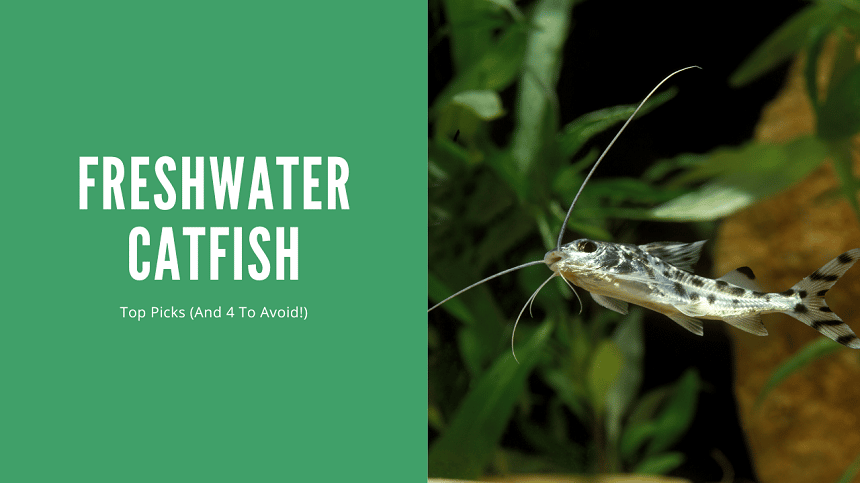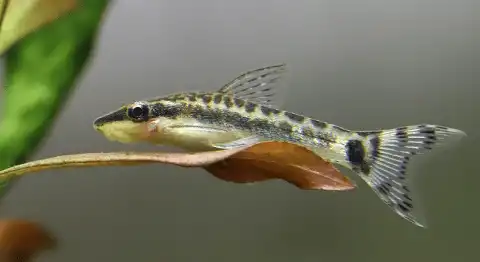Thank you for visiting! By the way… any links on this page that lead to products on Amazon and other stores/partners are affiliate links Aquarium Store Depot earns a commission if you make a purchase.
If you’re an aquarium enthusiast, or if you’re just getting into keeping fish tanks, then you may be wondering what types of freshwater catfish are available. There are many different species to choose from, and some make better choices than others. In this article, we’ll take a look at 10 great freshwater catfish options, as well as 4 that you may want to avoid. So whether you’re looking for a new addition to your tank or just doing some research before making your purchase, read on for some helpful information!
Key Takeaways
- Catfish are bottom dwelling fish that come in a variety of sizes
- The smallest Catfish are Cory Catfish. Some Catfish get so large they are not practical for home aquariums
- Some larger catfish will eat smaller fish while small catfish enjoy schooling
Introduction
In recent years, you may have heard of an extreme sport called noodling. This is when fishermen wade into shallow waters, stick their arms into muddy holes, and catch catfish with their bare hands. If you were not aware of this event or didn’t know what it was called, now you know!
Luckily, the aquarium hobby has removed all need for noodling and instead, makes hundreds of catfish species available to the average aquarium keeper without any mud.
Freshwater catfish are extremely popular to keep in the aquarium setting due to their unique appearances and bottom-dwelling behaviors. Sizes can range anywhere from less than one inch in the pygmy cory (Corydoras pygmaeus) all the way up to several feet with the expert-level redtail catfish (Phractocephalus hemioliopterus). Most of the smaller species also exhibit schooling behavior.
What Are they?
What are catfish, though? On the surface level, these are fish that have long whiskers protruding from the front of their face. These are actually called barbels and help catfish smell their surroundings as they scour the muddy and murky substrate for food.
Scientifically, catfish belong to the Siluriformes order. They are found on every continent and have adapted to living on the bottom of many waterways. The Mekong giant catfish (Pangasianodon gigas) is one of the largest fish in the world, knowingly growing to at least 9 feet and over 600 pounds.
What Types Live In Freshwater?
Most catfish live in freshwater. The most common saltwater catfish species are the hardhead catfish (Ariopsis felis) and the gafftopsail catfish (Bagre marinus) though they are not found in the aquarium hobby. The only true saltwater catfish species found in the aquarium hobby is the striped eel catfish also known as the coral catfish (Plotosus lineatus).
Are They Good For The Aquarium?
Catfish are great additions to the aquarium! Many species of catfish eat nuisance algae while others help clean up uneaten food and waste that collects at the bottom of the tank.
While mostly easy to care for, not all catfish are right for every setup. As we’ll see, some species need mature tanks while others need specific tank mates. Some of the larger species may even be considered predatory while others make for perfect community additions.
What Is The Smallest Kind?
Some of the smallest kinds of catfish only grow to be several centimeters long, like the newly discovered Pareiorhina hyptiorhachis from South America. In the aquarium hobby, one of the smallest pleco species available is the pygmy cory, which maxes out at about an inch.
Care
Catfish are relatively easy to care for. The waters they originate from are anything but pristine and catfish have adapted. One of these adaptations was the use of barbels for sensing their surroundings in murky environments.
Aquarium keepers like pristine conditions, though. So how does this translate to the home aquarium?
Aquarium Setup
While you don’t need to make a complete muddy mess out of your aquarium, catfish definitely prefer an aquarium with a soft substrate, like sand or silt. This will help prevent injury to their sensitive undersides while letting them sift for food.
In order to recreate the murkiness of their native waters, it’s strongly recommended to use tannins from organic botanicals, indian almond leaves, and dimmed aquarium lighting. Overly bright settings can cause your catfish to be even more nocturnal than most species already are.
In addition, driftwood and rocks may be added throughout the tank for structure. Catfish love to make burrows and caves for themselves, so everything added to the aquarium should be safely secured in place.
Tank Size
The recommended tank size for catfish will depend on the species. Most community species require at least a 10-20 gallon minimum tank size. The larger species need several hundred–or even several thousand–gallons of water for space to swim and to keep nutrients down.
Some of the most popular nano catfish species are:
- Cory catfish
- Otocinclus catfish
- Glass catfish
Filtration
Catfish need very heavy filtration. These fish are very messy eaters and create a lot of waste. Some species of fish, especially those that come from large river systems, also appreciate additional water flow that simulates currents.
Depending on the species of catfish, the ideal filtration would be rated for 4x the size of the aquarium. Because of this, many hobbyists use canister filters or sump filtration. Wavemakers and powerheads may be used to help create more movement throughout the tank. Just make sure that the substrate isn’t being kicked around and carried into the filtration.
High flow, large filtration capacity, and quality plumbing - The FX series is designed for monster fish keepers
If you’re only keeping small fish, like a school of cory catfish, then a regular sponge or hang on the back filter will be more than enough.
Tank Mates
Most catfish are peaceful fish that leave other fish alone. The problem is that most catfish have poor eyesight and a big appetite.
The general rule when keeping catfish is to not keep any fish that could fit into its mouth. Eventually, a large catfish will eat any smaller fish that are available in the aquarium.
Based on this rule, tank mates may be selected. Most nano catfish species will happily get along with the typical freshwater community fish like tetras, rasboras, and gouramis. Larger species of catfish can be kept with more predatory fish.
Apart from schooling catfish species, it’s never recommended to keep multiple catfish together. This is due to their size, waste, and territorial aggression that comes about as they mature.
10 Types Of Non-saline Kind For Aquariums
Here are the best types of catfish to add to the freshwater aquarium! Most of these stay reasonable sizes without having an overly demanding appetite. A few species of pleco have been added to this list as they are commonly sold alongside catfish.
I included a video above from our YouTube channel. We go over more in detail in the blog post below so be sure to check both out. If you like our content, be sure to subscribe as we post new videos every week!
1. Cory
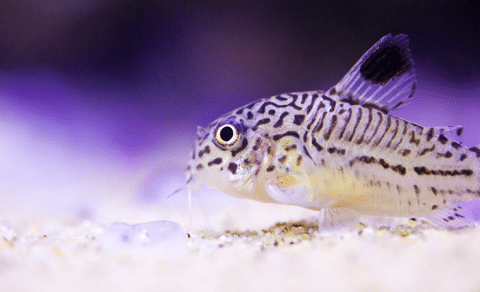
- Scientific Name: Corydoras spp.
- Common names: Corydoras, cory catfish, corys
- Minimum Tank Size: 10 gallons
- Adult Size: 1-3 inches on average
- Temperament: Peaceful
- Care Level: Easy
- Diet: Omnivore
- Origin: South America
- Temperature: 72-82°F
- pH: 6.5-7.5
Corydoras are arguably the most popular kind of aquarium catfish available, simply due to the fact that there are so many different kinds! These are schooling fish that are very active on the bottom of the tank. They use their barbels to sift through a sand substrate to find food, tracing back and forth across the front of the aquarium.
Some of the most popular species of Corydoras are:
- Panda cory (Corydoras panda)
- Bronze/green cory (Corydoras aeneus)
- Sterbai cory (Corydoras sterbai)
- Pygmy cory (Corydoras pygmaeus)
A smaller variety of Cory Catfish. Grows to less than 1.5 inches in length. A peaceful bottom dwelling fish
It is important to note that corys do not purposefully eat algae and won’t solve an algae problem. They can also live surprisingly long with some individuals knowingly surpassing 20 year of age.
2. Otocinclus
A small algae-eating fish. Also great with freshwater shrimp.
- Scientific Name: Otocinclus spp.
- Common names: Otocinclus catfish, Otocinclus, otos
- Minimum Tank Size: 10 gallon
- Adult Size: 2 inches
- Temperament: Peaceful
- Care Level: Moderate
- Diet: Herbivore
- Origin: South America
- Temperature: 74-82°F
- pH: 6.5-7.5
Otos are hands-down one of the best fish available for the freshwater aquarium. These are small schooling fish with a big appetite for algae. They have been known to clear a tank of most nuisance algae within a matter of days. This can become a problem for hobbyists who try to add otocinclus catfish to an immature tank, though.
Otos are more difficult to keep than expected. They have a high need for algae and other greens due to their strictly herbivorous diet. They can also be skittish and do better in larger schools with other peaceful fish. Because of their size, a 10 gallon tank is recommended but a 20 gallon tank will sustain them longer.
The otocinclus catfish is commonly confused with the Siamese algae eater (Crossocheilus oblongus) and the Chinese algae eater (Gyrinocheilus aymonieri).
3. Pictus
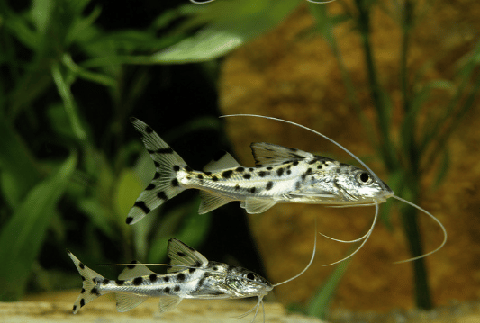
- Scientific Name: Pimelodus pictus
- Common names: Pictus catfish, angel catfish
- Minimum Tank Size: 75 gallon
- Adult Size: 5 inches
- Temperament: Peaceful
- Care Level: Easy
- Diet: Omnivore
- Origin: South America
- Temperature: 75-82°F
- pH: 6.5-7.5
The pictus catfish is a beautiful species with black and white spots over iridescent scales. These fish have a typical catfish body with a high dorsal fin, flattened stomach, and long barbels. They are not difficult to keep in the aquarium setting, though they are a larger schooling fish that requires a big aquarium.
Though one of the larger species available, they are community tank friendly as long as tank mates are bigger than their mouths or are able to outswim a hungry catfish!
4. Bristlenose Pleco
The Bristlenose Pleco is a smaller Pleco that does a great job of eating algae. Peaceful and gets along with most fish
- Scientific Name: Ancistrus spp.
- Common names: Bristlenose pleco, bushynose pleco
- Minimum Tank Size: 30 gallon
- Adult Size: 5 inches
- Temperament: Peaceful
- Care Level: Easy
- Diet: Omnivore
- Origin: South America
- Temperature: 72-82°F
- pH: 6.5-7.5
Also known as the bushy nose pleco, the bristlenose pleco is a very popular and more manageable alternative to the common pleco. These plecos are named after the unique cluster of short barbels that cover their face. Otherwise, they look nearly identical to other pleco species but stay at a much more manageable size.
The bristlenose pleco is not a true catfish but is often misidentified as one.
Bristlenose plecos are peaceful fish, but they can be aggressive with their own species and other similar-looking fish. Because of this, they should be the only bottom-dwelling species in the tank unless there is plenty of space and hiding spots for other fish.
Though it might seem like the bristlenose pleco would eat tons of algae, they are an omnivorous species that prefers leftover meaty foods.
5. Upside Down
- Scientific Name: Synodontis nigriventris
- Common names: Upside down catfish, blotched upside down catfish
- Minimum Tank Size: 30 gallons
- Adult Size: 5 inches
- Temperament: Peaceful
- Care Level: Easy
- Diet: Omnivore
- Origin: Central Africa
- Temperature: 75-82°F
- pH: 6.0-7.5
Yes, the upside down catfish actually swims upside down. Check out the crazy video from PBS above! These unique fish are built like other catfish species and share similar colorations, but they like to swim with their mouths pointing up! Because of this, they can regularly be seen at the top of the water searching for and eating food.
The upside down catfish is a schooling species and will appreciate being in small groups of at least 3 or 4 individuals.
6. Alberti
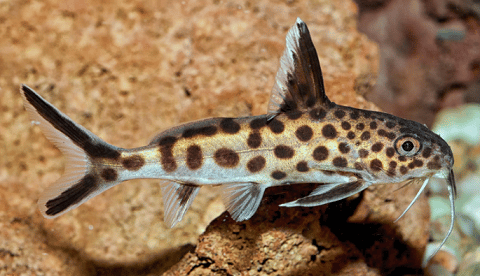
- Scientific Name: Synodontis alberti
- Common names: Alberti catfish, bigeye squeaker, Albert’s Synodontis
- Minimum Tank Size: 30 gallon
- Adult Size: 6-8 inches
- Temperament: Peaceful
- Care Level: Easy
- Diet: Omnivore
- Origin: Democratic Republic of Congo, Cameroon, Republic of Congo
- Temperature: 72-82°F
- pH: 6.0-8.0
One of the more uncommon catfish species to find in the aquarium hobby, the Alberti catfish, also known as the high-fin Synodontis, has some of the longest barbels you will see! In fact, this species has the longest whiskers out of all the members of its related genus.
The Alberti catfish is a peaceful catfish that prefers to have its own space. Hobbyists have successfully kept multiple Alberti catfish together, but this should only be attempted in larger aquariums. They should only be kept with larger tank mates.
7. Glass

- Scientific Name: Kryptopterus vitreolus
- Common names: Glass catfish, ghost catfish, phantom catfish
- Minimum Tank Size: 30 gallon
- Adult Size: 4 inches
- Temperament: Peaceful
- Care Level: Moderate
- Diet: Omnivore
- Origin: Thailand
- Temperature: 72-82°F
- pH: 6.5-7.5
Whether you’re looking for a catfish that doesn’t live on the bottom of the tank or just want a fish that doesn’t look like any other species of tropical fish, the glass catfish ticks both boxes. These fish are completely clear, exposing their skeleton, organs, and long barbels.
These are peaceful community fish that enjoy being in each other’s company. However, like other catfish, glass catfish like dimmed conditions. They’re also willing to eat whatever can fit into their mouths, so tank mates should be chosen carefully.
8. Twig
- Scientific Name: Farlowella acus
- Common names: Twig catfish, whiptail catfish
- Minimum Tank Size: 55 gallon
- Adult Size: 6 inches
- Temperament: Peaceful
- Care Level: Moderate
- Diet: Omnivore
- Origin: South America
- Temperature: 72-82°F
- pH: 6.5-7.0
A master of camouflage, the twig catfish (video source) is named after its uncanny resemblance to a piece of bark. These fish are long and skinny with pointed noses, making it hard to believe they’re a type of true catfish.
Twig catfish can be pretty skittish in the aquarium and will prefer being kept with other peaceful fish in dimmed lighting. Keeping twig catfish in a small group or in pairs may help them be more upfront and center in the aquarium.
While omnivores, twig catfish are mainly herbivores and need to be given algae and a plant-based diet.
9. Asian Stone
- Scientific Name: Hara jerdoni
- Common names: Asian stone catfish, moth catfish, anchor catfish
- Minimum Tank Size: 5 gallon
- Adult Size: 1 inch
- Temperament: Peaceful
- Care Level: Moderate
- Diet: Omnivore
- Origin: India, Bangladesh
- Temperature: 64-75°F
- pH: 5.5-7.5
Possibly even more camouflaged than the twig catfish, the Asian stone catfish (video source) is the perfect catfish species for a nano or even pico freshwater aquarium. These fish are incredibly small and generally inactive once established. They only grow to be about an inch big and will spend their time searching for food in sandy and muddy bottoms.
These fish are more difficult to keep than other catfish species. They originate from waterways with high levels of dissolved oxygen, which needs to be replicated in the aquarium. Because they’re commonly kept in smaller aquariums, water parameters can also be more difficult to monitor and control.
10. Bumblebee
- Scientific Name: Microglanis iheringi
- Common names: Bumblebee catfish
- Minimum Tank Size: 20 gallon
- Adult Size: 2 inches
- Temperament: Peaceful
- Care Level: Moderate
- Diet: Omnivore (mainly insectivore)
- Origin: Venezuela and Colombia
- Temperature: 72-82°F
- pH: 6.5-7.5
Not to be confused with the bumblebee goby (Brachygobius xanthozonus), the bumblebee catfish can be similar in appearance to the unknowing hobbyist. The main difference is that bumblebee catfish exhibit the typical catfish body with barbels sticking out from their mouth.
The bumblebee catfish (video source) can be difficult to find for sale. Once in the aquarium, they are small peaceful fish. They can be somewhat more challenging than other species of catfish as they are mainly insectivores in the wild, feeding mostly on ants. In the aquarium, they can adapt to a larger selection of live, frozen, and freeze-dried options.
Species To Avoid
Not all catfish are created equal though. In fact, most catfish species of unsuitable for the aquarium setting due to their monster size.
Here are some of the species that are still regularly sold in fish stores that the average hobbyist should avoid.
1. Redtail

- Scientific Name: Phractocephalus hemioliopterus
- Common names: Redtail catfish
- Minimum Tank Size: 2700 gallon
- Adult Size: 5 feet
- Temperament: Semi-aggressive
- Care Level: Expert
- Diet: Omnivore
- Origin: South America
- Temperature: 70-79° F
- pH: 6.0-7.5
The redtail catfish is so massive that it is believed to be the monster fish behind the drownings of victims from the Sobral Santos II that sank on the Amazon River in 1981.
There is no denying that the redtail catfish is one of the most attractive catfish species available in the hobby, but keeping one is unrealistic for most aquarium keepers. Hobbyists would require a massive setup with heavy filtration and carefully chosen tank mates. These fish have been known to be aggressive to other fish that try to invade their territory.
2. Tiger Shovelnose

- Scientific Name: Pseudoplatystoma fasciatum
- Common names: Tiger shovelnose catfish, tiger catfish
- Minimum Tank Size: 200 gallon
- Adult Size: 3 feet
- Temperament: Aggressive
- Care Level: Expert
- Diet: Omnivore
- Origin: South America
- Temperature: 75-82°F
- pH: 6.0-8.0
The tiger shovelnose catfish is another beautiful fish that simply won’t work in the average home aquarium. These fish have beautiful colorations with a silver body and thin vertical stripes from their head to tail, earning them their name. They also have a unique flattened head with very long whiskers.
Though smaller than the massive redtail catfish, the tiger shovelnose catfish is aggressive and needs plenty of room to itself. While a single catfish can be kept in a traditional glass aquarium, in theory, it’s strongly recommended to only keep them in pool or pond settings.
Interestingly, the tiger shovelnose catfish has been hybridized with the redtail catfish.
3. Paroon Shark (Giant Pangasius)
- Scientific Name: Pangasius sanitwongsei
- Common names: Paroon shark, giant pangasius, pangasid-catfish, Chao Phraya giant catfish
- Minimum Tank Size: N/A
- Adult Size: 9 feet
- Temperament: Semi-aggressive
- Care Level: Expert
- Diet: Omnivore
- Origin: Southeast Asia
- Temperature: 75-82°F
- pH: 6.5-7.5
The paroon shark is a critically endangered fish that is very similar in appearance and origin to the Mekong giant catfish. Sadly, these fish have been overharvested and collected for the aquarium trade where they are sold while they are only a few inches long. Buyers are usually completely unaware of their potential size and over 20 year lifespan!
Not only does their size make them unsuitable for the home aquarium, but they also become very nervous when placed in confined places. As a result, they bang into the walls and injure themselves, which can lead to infection and death.
4. Common pleco (Suckermouth)
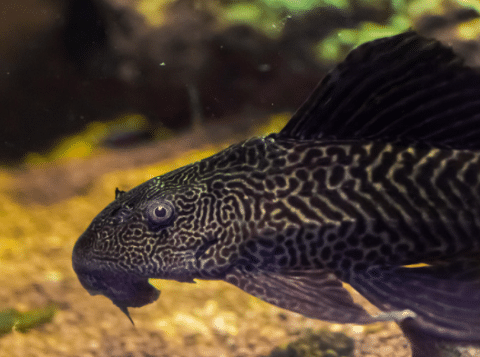
- Scientific Name: Hypostomus plecostomus
- Common names: Common pleco, pleco, suckermouth catfish, spotted pleco
- Minimum Tank Size: 150 gallon
- Adult Size: 2 feet
- Temperament: Semi-aggressive
- Care Level: Moderate
- Diet: Omnivore
- Origin: South America
- Temperature: 72-82°F
- pH: 6.5-7.5
Last but not least, the common pleco is definitely one of the catfish-like species you should avoid when going to purchase a fish. Remember, these are not true catfish but they are often lumped together!
Common plecos fish are everywhere; they are readily available, relatively inexpensive, and advertised as only growing to the size of the tank–which is a complete lie!
Common plecos are commonly sold as juveniles while they’re only a few inches long. In a matter of time, they will quickly grow closer to 10 inches, which can potentially turn into 2 feet. Though it might seem like they’re herbivores with their suckermouths, they are omnivores that won’t hesitate to be the first to eat any available food that enters the system. In addition, they can become very territorial, especially towards similarly sized fish.
Final Thoughts
Catfish come in all shapes and sizes. The aquarium hobby has made many peaceful, schooling fish species available that are perfect for the community tank. Unfortunately, a few monster catfish have also been thrown into the mix that are meant for experts only.
Luckily, almost all catfish have the same care requirements and curious attitudes.
- About the Author
- Latest Posts
I’m thrilled that you found Aquarium Store Depot! Here you’ll find information on fish, aquariums, and all things aquatics related. I’m a hobbyist (being doing this since I was 11) and here to help other hobbyists thrive with their aquariums! I adhere to a high quality Editorial Process and Review products with real life field usage and practical analysis.

